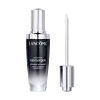Lancôme Advanced Génifique Youth Activating Concentrate Versus Clinique Moisture Surge™ Hydrating Supercharged Concentrate
What's inside
What's inside
 Key Ingredients
Key Ingredients

 Benefits
Benefits

 Concerns
Concerns

 Ingredients Side-by-side
Ingredients Side-by-side

Water
Skin ConditioningBifida Ferment Lysate
Skin ConditioningGlycerin
HumectantAlcohol Denat.
AntimicrobialDimethicone
EmollientHydroxyethylpiperazine Ethane Sulfonic Acid
BufferingAscorbyl Glucoside
AntioxidantSodium Hyaluronate
HumectantSodium Hydroxide
BufferingSodium Benzoate
MaskingPhenoxyethanol
PreservativeAdenosine
Skin ConditioningFaex Extract
Skin ConditioningPEG-20 Methyl Glucose Sesquistearate
EmulsifyingPEG-60 Hydrogenated Castor Oil
EmulsifyingSalicyloyl Phytosphingosine
Skin ConditioningAmmonium Polyacryloyldimethyl Taurate
Emulsion StabilisingLimonene
PerfumingXanthan Gum
EmulsifyingCaprylyl Glycol
EmollientDisodium EDTA
Octyldodecanol
EmollientCitronellol
PerfumingParfum
MaskingWater, Bifida Ferment Lysate, Glycerin, Alcohol Denat., Dimethicone, Hydroxyethylpiperazine Ethane Sulfonic Acid, Ascorbyl Glucoside, Sodium Hyaluronate, Sodium Hydroxide, Sodium Benzoate, Phenoxyethanol, Adenosine, Faex Extract, PEG-20 Methyl Glucose Sesquistearate, PEG-60 Hydrogenated Castor Oil, Salicyloyl Phytosphingosine, Ammonium Polyacryloyldimethyl Taurate, Limonene, Xanthan Gum, Caprylyl Glycol, Disodium EDTA, Octyldodecanol, Citronellol, Parfum
Water
Skin ConditioningGlycerin
HumectantButylene Glycol
HumectantPhenyl Trimethicone
Skin ConditioningPropanediol
SolventSucrose
HumectantHydroxyethyl Urea
HumectantAlteromonas Ferment Extract
Skin ConditioningHydrolyzed Rice Extract
Skin ConditioningAcetyl Glucosamine
Skin ConditioningTrehalose
HumectantAlgae Extract
EmollientCaffeine
Skin ConditioningCholesterol
EmollientAloe Barbadensis Leaf Water
MaskingSodium Hyaluronate
HumectantPentaerythrityl Tetraethylhexanoate
EmollientDextrin Palmitate
EmulsifyingAcrylates/C10-30 Alkyl Acrylate Crosspolymer
Emulsion StabilisingSorbitol
HumectantSodium Polyaspartate
HumectantTocopheryl Acetate
AntioxidantCarbomer
Emulsion StabilisingDehydroxanthan Gum
Emulsion StabilisingCitric Acid
BufferingTetrahexyldecyl Ascorbate
AntioxidantBenzophenone-4
UV AbsorberPentaerythrityl Tetra-Di-T-Butyl Hydroxyhydrocinnamate
AntioxidantSodium Hydroxide
BufferingSodium Citrate
BufferingDisodium EDTA
BHT
AntioxidantChlorphenesin
AntimicrobialPhenoxyethanol
PreservativeCI 14700
Cosmetic ColorantCI 19140
Cosmetic ColorantWater, Glycerin, Butylene Glycol, Phenyl Trimethicone, Propanediol, Sucrose, Hydroxyethyl Urea, Alteromonas Ferment Extract, Hydrolyzed Rice Extract, Acetyl Glucosamine, Trehalose, Algae Extract, Caffeine, Cholesterol, Aloe Barbadensis Leaf Water, Sodium Hyaluronate, Pentaerythrityl Tetraethylhexanoate, Dextrin Palmitate, Acrylates/C10-30 Alkyl Acrylate Crosspolymer, Sorbitol, Sodium Polyaspartate, Tocopheryl Acetate, Carbomer, Dehydroxanthan Gum, Citric Acid, Tetrahexyldecyl Ascorbate, Benzophenone-4, Pentaerythrityl Tetra-Di-T-Butyl Hydroxyhydrocinnamate, Sodium Hydroxide, Sodium Citrate, Disodium EDTA, BHT, Chlorphenesin, Phenoxyethanol, CI 14700, CI 19140
 Reviews
Reviews

Ingredients Explained
These ingredients are found in both products.
Ingredients higher up in an ingredient list are typically present in a larger amount.
Disodium EDTA plays a role in making products more stable by aiding other preservatives.
It is a chelating agent, meaning it neutralizes metal ions that may be found in a product.
Disodium EDTA is a salt of edetic acid and is found to be safe in cosmetic ingredients.
Learn more about Disodium EDTAGlycerin is already naturally found in your skin. It helps moisturize and protect your skin.
A study from 2016 found glycerin to be more effective as a humectant than AHAs and hyaluronic acid.
As a humectant, it helps the skin stay hydrated by pulling moisture to your skin. The low molecular weight of glycerin allows it to pull moisture into the deeper layers of your skin.
Hydrated skin improves your skin barrier; Your skin barrier helps protect against irritants and bacteria.
Glycerin has also been found to have antimicrobial and antiviral properties. Due to these properties, glycerin is often used in wound and burn treatments.
In cosmetics, glycerin is usually derived from plants such as soybean or palm. However, it can also be sourced from animals, such as tallow or animal fat.
This ingredient is organic, colorless, odorless, and non-toxic.
Glycerin is the name for this ingredient in American English. British English uses Glycerol/Glycerine.
Learn more about GlycerinPhenoxyethanol is a preservative that has germicide, antimicrobial, and aromatic properties. Studies show that phenoxyethanol can prevent microbial growth. By itself, it has a scent that is similar to that of a rose.
It's often used in formulations along with Caprylyl Glycol to preserve the shelf life of products.
Sodium Hyaluronate is hyaluronic acid's salt form. It is commonly derived from the sodium salt of hyaluronic acid.
Like hyaluronic acid, it is great at holding water and acts as a humectant. This makes it a great skin hydrating ingredient.
Sodium Hyaluronate is naturally occurring in our bodies and is mostly found in eye fluid and joints.
These are some other common types of Hyaluronic Acid:
Learn more about Sodium HyaluronateSodium Hydroxide is also known as lye or caustic soda. It is used to adjust the pH of products; many ingredients require a specific pH to be effective.
In small amounts, sodium hydroxide is considered safe to use. However, large amounts may cause chemical burns due to its high alkaline.
Your skin has a natural pH and acid mantle. This acid mantle helps prevent harmful bacteria from breaking through. The acid mantle also helps keep your skin hydrated.
"Alkaline" refers to a high pH level. A low pH level would be considered acidic.
Learn more about Sodium HydroxideWater. It's the most common cosmetic ingredient of all. You'll usually see it at the top of ingredient lists, meaning that it makes up the largest part of the product.
So why is it so popular? Water most often acts as a solvent - this means that it helps dissolve other ingredients into the formulation.
You'll also recognize water as that liquid we all need to stay alive. If you see this, drink a glass of water. Stay hydrated!
Learn more about Water